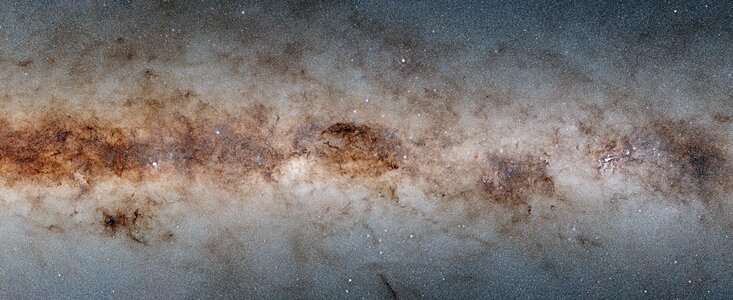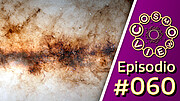Billions of Celestial Objects Revealed in Gargantuan Survey of the Milky Way
NSF’s NOIRLab releases colossal astronomical data tapestry displaying the majesty of our Milky Way in unprecedented detail
18 January 2023
Astronomers have released a gargantuan survey of the galactic plane of the Milky Way. The new dataset contains a staggering 3.32 billion celestial objects — arguably the largest such catalog so far. The data for this unprecedented survey were taken with the Dark Energy Camera, built by the US Department of Energy, at the NSF’s Cerro Tololo Inter-American Observatory in Chile, a Program of NOIRLab.
The Milky Way Galaxy contains hundreds of billions of stars, glimmering star-forming regions, and towering dark clouds of dust and gas. Imaging and cataloging these objects for study is a herculean task, but a newly released astronomical dataset known as the second data release of the Dark Energy Camera Plane Survey (DECaPS2) reveals a staggering number of these objects in unprecedented detail. The DECaPS2 survey, which took two years to complete and produced more than 10 terabytes of data from 21,400 individual exposures, identified approximately 3.32 billion objects — arguably the largest such catalog compiled to date. Astronomers and the public can explore the dataset here.
This unprecedented collection was captured by the Dark Energy Camera (DECam) instrument on the Víctor M. Blanco 4-meter Telescope at Cerro Tololo Inter-American Observatory (CTIO), a Program of NSF's NOIRLab. CTIO is a constellation of international astronomical telescopes perched atop Cerro Tololo in Chile at an altitude of 2200 meters (7200 feet). CTIO’s lofty vantage point gives astronomers an unrivaled view of the southern celestial hemisphere, which allowed DECam to capture the southern Galactic plane in such detail.
DECaPS2 is a survey of the plane of the Milky Way as seen from the southern sky taken at optical and near-infrared wavelengths. The first trove of data from DECaPS was released in 2017, and with the addition of the new data release, the survey now covers 6.5% of the night sky and spans a staggering 130 degrees in length. While it might sound modest, this equates to 13,000 times the angular area of the full Moon.
The DECaPS2 dataset is available to the entire scientific community and is hosted by NOIRLab’s Astro Data Lab, which is part of the Community Science and Data Center. Interactive access to the imaging with panning/zooming inside of a web-browser is available from the Legacy Survey Viewer, the World Wide Telescope and Aladin.
Most of the stars and dust in the Milky Way are located in its disk — the bright band stretching across this image — in which the spiral arms lie. While this profusion of stars and dust makes for beautiful images, it also makes the Galactic plane challenging to observe. The dark tendrils of dust seen threading through this image absorb starlight and blot out fainter stars entirely, and the light from diffuse nebulae interferes with any attempts to measure the brightness of individual objects. Another challenge arises from the sheer number of stars, which can overlap in the image and make it difficult to disentangle individual stars from their neighbors.
Despite the challenges, astronomers delved into the Galactic plane to gain a better understanding of our Milky Way. By observing at near-infrared wavelengths, they were able to peer past much of the light-absorbing dust. The researchers also used an innovative data-processing approach, which allowed them to better predict the background behind each star. This helped to mitigate the effects of nebulae and crowded star fields on such large astronomical images, ensuring that the final catalog of processed data is more accurate.
“One of the main reasons for the success of DECaPS2 is that we simply pointed at a region with an extraordinarily high density of stars and were careful about identifying sources that appear nearly on top of each other,” said Andrew Saydjari, a graduate student at Harvard University, researcher at the Center for Astrophysics | Harvard & Smithsonian and lead author of the paper. “Doing so allowed us to produce the largest such catalog ever from a single camera, in terms of the number of objects observed.”
“When combined with images from Pan-STARRS 1, DECaPS2 completes a 360-degree panoramic view of the Milky Way's disk and additionally reaches much fainter stars,” said Edward Schlafly, a researcher at the AURA-managed Space Telescope Science Institute and a co-author of the paper describing DECaPS2 published in the Astrophysical Journal Supplement. “With this new survey, we can map the three-dimensional structure of the Milky Way's stars and dust in unprecedented detail.”
“Since my work on the Sloan Digital Sky Survey two decades ago, I have been looking for a way to make better measurements on top of complex backgrounds," said Douglas Finkbeiner, a professor at the Center for Astrophysics, co-author of the paper, and principal investigator behind the project. “This work has achieved that and more!"
“This is quite a technical feat. Imagine a group photo of over three billion people and every single individual is recognizable!” says Debra Fischer, division director of Astronomical Sciences at NSF. “Astronomers will be poring over this detailed portrait of more than three billion stars in the Milky Way for decades to come. This is a fantastic example of what partnerships across federal agencies can achieve.”
DECam was originally built to carry out the Dark Energy Survey, which was conducted by the Department of Energy and the US National Science Foundation between 2013 and 2019.
More information
This dataset was presented in the paper “The Dark Energy Camera Plane Survey 2 (DECaPS2): More Sky, Less Bias, and Better Uncertainties” to appear in the Astrophysical Journal Supplement. https://doi.org/10.3847/1538-4365/aca594
The DECaPS2 team is composed of A. K. Saydjari (Harvard University and the Center for Astrophysics | Harvard & Smithsonian), E. F. Schlafly (Space Telescope Science Institute), D. Lang (Perimeter Institute for Theoretical Physics and University of Waterloo), A. M. Meisner (NSF’s NOIRLab), G. M. Green (Max Planck Institute for Astronomy), C. Zucker (Space Telescope Science Institute and the Center for Astrophysics | Harvard & Smithsonian), I. Zelko (Canadian Institute of Theoretical Astrophysics — University of Toronto), J. S. Speagle (University of Toronto), T. Daylan (Princeton University), A. Lee (Bill & Melinda Gates Foundation), F. Valdes (NSF’s NOIRLab), D. Schlegel (Lawrence Berkeley National Laboratory), and D. P. Finkbeiner (Harvard University and the Center for Astrophysics | Harvard & Smithsonian).
NSF’s NOIRLab (National Optical-Infrared Astronomy Research Laboratory), the US center for ground-based optical-infrared astronomy, operates the international Gemini Observatory (a facility of NSF, NRC–Canada, ANID–Chile, MCTIC–Brazil, MINCyT–Argentina, and KASI–Republic of Korea), Kitt Peak National Observatory (KPNO), Cerro Tololo Inter-American Observatory (CTIO), the Community Science and Data Center (CSDC), and Vera C. Rubin Observatory (in cooperation with DOE’s SLAC National Accelerator Laboratory). It is managed by the Association of Universities for Research in Astronomy (AURA) under a cooperative agreement with NSF and is headquartered in Tucson, Arizona. The astronomical community is honored to have the opportunity to conduct astronomical research on Iolkam Du’ag (Kitt Peak) in Arizona, on Maunakea in Hawai‘i, and on Cerro Tololo and Cerro Pachón in Chile. We recognize and acknowledge the very significant cultural role and reverence that these sites have to the Tohono O’odham Nation, to the Native Hawaiian community, and to the local communities in Chile, respectively.
Links
- Research paper
- Photos of the Víctor M. Blanco 4-meter Telescope
- Videos of the Víctor M. Blanco 4-meter Telescope
Interactive Viewing of Dataset
Contacts
Andrew Saydjari
Center for Astrophysics | Harvard & Smithsonian
Email: andrew.saydjari@cfa.harvard.edu
Charles Blue
Public Information Officer
NSF’s NOIRLab
Tel: +1 202 236 6324
Email: charles.blue@noirlab.edu








